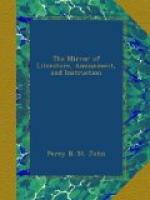On this island, Buache, or Garden (as the party named it) Captain Stirling left a cow, two ewes in lamb, and three goats, where, he observes, abundance of grass, and a large pool of water awaited them. They would be, at all events, perfectly free from any disturbance from the natives.
Rottenest Island is the largest in this quarter, being about eight miles in length; it contains several saline lagoons, separated from the sea, on the north-east side, by a beach composed mostly of a single species of bivalve shell. Like Buache, it is covered with an abundant and vigorous vegetation, and a small species of kangaroo is said by Freycinet to be numerous upon it. Vlaming, who first discovered it, speaks in raptures of the beauties of this island, to which, from the multitude of rats, as he thought them to be, he gave the name of the “Rats’ Nest.” The French call this animal the preamble ... long new.
It is not to be supposed that a hasty visit could enable the party to explore the mineralogical resources of the country. It appears, however, by a list of the soils and rock formations in Captain Stirling’s report, that he brought home specimens of copper ore, of lead ore with silver, and also with arsenic, two species of magnetic iron, several varieties of granite, and chalcedony, and of limestone, with stalagmite incrustations, &c. The high cliffs of Cape Naturaliste abound with large masses of what Mr. Fraser calls “an extraordinary aggregate,” containing petrifactions of bivalve and other marine shells, every particle of which was thickly incrusted with minute crystals. Here, too, he says, veins of iron of considerable thickness were seen to traverse the rock in various directions; and he speaks of the caverns formed in the minacious schistose between the granite and the limestone, as something very extraordinary. They contained rock-salt in large quantities, forming thick incrustations on every part of the surface, beautifully crystallized, and penetrating into the most compact parts of the rock. In many of these caverns were very brilliant stalactites and stalagmites of extraordinary size adhering to the nodules of granite which form their bases or floors, and which are from forty to fifty feet above the level of the sea.
In several parts of the limestone formation, mineral springs were found; one in particular was noticed within half a mile of the entrance into Swan River. It bubbled out at the base of the solid rock in a stream, whose transverse area was measured by Captain Stirling, and found to be from six to seven feet, running at the rate of three feet in a second of time. It was thermal, saline, pleasant to the taste, and some, who partook of it, attributed to it an aperient quality.
Such is the outline of a country on which the government have determined to establish a colony, and over which they have justly, and we think judiciously, appointed Captain Stirling to act as lieutenant-governor. The plan on which it is to be founded is, in our opinion, unobjectionable. It promises the most advantageous terms to qualified settlers, and deserves only to be known to ensure as many of the most respectable agriculturists as may in the first instance be desirable.




